

Victoria Station, Manchester
Lancashire & Yorkshire Railway
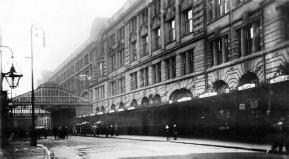
EXTERIOR OF VICTORIA STATION, Manchester.
FROM some sequestered village in the wilds of Yorkshire to Manchester may seem a far cry. But even a wayside station has interest and attractiveness closely akin to that of a great metropolitan station. To village people, the station is the centre of importance, because through its means they may touch at least the fringes of the wider and busier life which lies beyond their ordinary sphere. Slight though it be there is a thrill in that touch. It may be felt only by the message boys, the artisans, the farm labourers, and others who frequent a wayside station of an evening when the last train arrives from the junction. Even to them the station and the arrival of the trains speak of worlds of life beyond, yet whose sounds they cannot hear. If the spirit of ambition or adventure lurks in their blood, it is to the railway station they go, as the place where the life they would know seems to come in to them in the eddy of its stream. There the bustle, the news, the travellers, and the trains carry suggestions to their imaginations and spur their laggard minds to think. They watch the “tail-
As everyone should know, the headquarters of the Lancashire and Yorkshire Railway are at Manchester and its principal station there is Victoria. It is situated near the centre of the City, within a quarter of a mile of the Exchange, and is thus easily accessible. It is purely a passenger station, the goods traffic of the Lancashire and Yorkshire Railway being conducted through Oldham Road and Salford stations chiefly. As one approaches the main entrance of the station from Corporation Street, one is confronted by a handsome block of buildings, the property of the Lancashire and Yorkshire Railway and devoted principally to its offices. In front of these buildings there is a broad carriage-
Each platform is duly numbered and marked, so that there is no confusion. With an efficient staff, the station arrangements are conducted with order and method to a degree. Ready answers are given to enquirers regarding trains, but the public are made independent of such help by there being provided in a conspicuous place a permanent indicator giving details as to hours of departure and platforms for all trains. The general appearance of the station is bright and airy. With its high glass roofs, it is well lighted and ventilated. It is compact without being congested; and roomy without being scattered. From side to side of the station there is carried overhead a narrow iron bridge reserved for the transportation of passengers’ luggage and fitted with hoists at various points. By its means, masses of luggage can be expeditiously handled, without the platforms being blocked or in any way interfered with.
In passing, it may be mentioned how well worth a visit is the new Dining Hall, which forms part of the main station buildings. In the roof is a beautiful glass dome, richly decorated, and the whole appearance of the Hall is inviting, being equipped in a manner equal to any first class Hotel or Club.
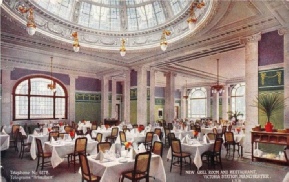
GRILL ROOM OF THE RESTAURANT at Victoria Station, Manchester.
To the right of the bays for local trains, but partitioned off from them, is a Fish Dock which is used for dealing with the early morning fish trains. Fish carts come alongside the platform here, and in the shortest possible time wagon-
But subways are dungeons at best! Cheerless and gloomy, they oppress the feelings. Only here and there do stray beams of light find their way in, and the sudden rumbling of passing trains overhead sends tremors to the heart. People approaching at some distance in a subway seem ghostly, and passing us appear unlike themselves. The walls reverberating with the sounds of our voices seem also to have ears.
If, however we nerve ourselves to traverse the whole length of the subway at Victoria Station, we come out at the platform and the lines which extend westward for nearly a quarter of a mile into the Exchange Station of the London and North Western Railway. The Lancashire and Yorkshire Railway and the London and North Western Railway are on the most friendly and intimate terms, and run various trains through their respective stations into the station of the other Company. The London and North Western Railway also avails itself of running powers on the Lancashire and Yorkshire system through Victoria Station as far as Stalybridge in running its own trains to Leeds, York and the North-
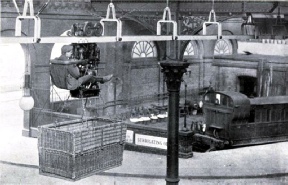
THE ELECTRIC PARCELS RAILWAY, Victoria Station, Manchester.
At the west end of the station is situated the Parcel Office, one of the busiest departments of the station. In dealing with parcels traffic two requisites are mainly necessary, viz. quick transit, with as little handling as possible. When large numbers of parcels of varying bulk have to be handled one after the other by various officials, first on delivery being taken, then on being “sorted”, and again on being conveyed to the parcel vans on different trains, it is evident that much time and labour is lost. There is also more risk of parcels being injured or lost, and their transit is delayed. At the Manchester Victoria Station there is an ingenious device called a Parcel Carrier in use for dealing with parcels traffic, by which the above requisites of quick transit and little handling are obtained. It is an electric overhead trolley, running on a double rail of very narrow gauge, half-
The Lancashire and Yorkshire Railway -
The Railway crosses more or less at right angles all the North and South lines, and therefore affords an excellent means of communication with other parts of the Kingdom.
Its main line runs from Liverpool on the west coast through Wigan, Bolton, Rochdale and Wakefield to Goole and Hull on the east coast.
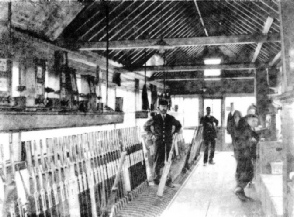 INTERIOR OF EAST JUNCTION SIGNAL CABIN, Victoria Station, Manchester.
INTERIOR OF EAST JUNCTION SIGNAL CABIN, Victoria Station, Manchester.
It serves the following important towns in Lancashire and Yorkshire:-
But a station cannot be known or its importance truly estimated from its platforms alone. It is necessary to be acquainted with its environs and its exits and approaches by rail. Out of the station proceed myriads of railway lines, curving, intersecting, intermingling, diverging and converging, like the veins in a man’s hand.
Following them out a short distance one passes the water columns from which engines are supplied; two turntables and pits on which engines may be turned and overhauled; and a gasometer from which the tanks below the railway carriages may be supplied.
A few hundred yards beyond the outer extremities of the various platforms at Victoria, of which mention has been made, there are erected at short intervals three galleries of signals stretching right across the network of rails. Signals of varying height, size, and denomination, they stand like sentinels on guard.
They are controlled from three large signal cabins, one being reserved for the local or “home” lines; the second for “through” or main lines; and the third controlling both local and main line traffic proceeding in the direction of Miles Platting. The “arms” now outstretched in warning, with unmistakable sternness, forbidding entrance to incoming trains on certain lines at their peril, or now lowered in sanction for the arrival or departure of trains, as if bowing stiffly in grave assent. Each has its own line of rails to guard, yet not without inter-
In admiring them, let us not forget also the inventive genius and skill of the engineers who planned and laid down so elaborate and complete a system of signalling.
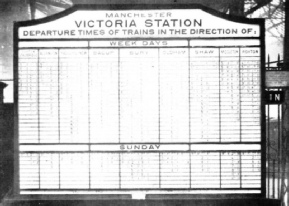
THE TRAIN DESTINATION INDICATOR AT Victoria Station, Manchester.
Standing near the first of these galleries of signals, one can grasp the whole conception and scheme of the station. Near this point there converge two distinct groups of lines, sweeping round in full curves until they reach the “base”, from which they run parallel into the station. There are here as many as twenty-
As two of these lines enter the station they run in what is called a “double-
To give some idea of the number of trains dealt with at this place, which is known as East Junction, it may be stated that the number of trains using the Junction averages 1,300 per day, this figure including ordinary, special, and empty carriage trains, also engines, goods trains and shunting engines. In times of fog a staff of no fewer than 170 fogmen may be required at and about Victoria Station.
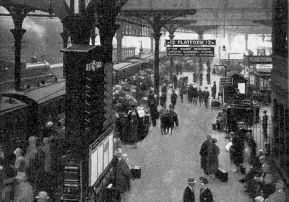 TYPICAL HOLIDAY CROWDS ON No. 12 PLATFORM, Victoria Station, Manchester.
TYPICAL HOLIDAY CROWDS ON No. 12 PLATFORM, Victoria Station, Manchester.
Let us stand on one of the wooden “ islands” in the middle of the network of rails at this “base” (where none but level-
Inspectors of traffic have most responsible work. Not only must the Inspector know all the minutiae of the traffic regulations connected with the station; not only has he to rely in a particular manner on the co-
But it is dusk, and we retrace our steps into the station. Its lights are lit, and it suggests the thought which has come to the hearts of many -
Its shelter, its brightness, and its interest are inviting. Our eyes may greet even some railway carriages like old acquaintances. So may even inanimate things like these cheer human hearts, perhaps awaking memories of the distant and the past, but making the present hour kindly and fragrant with content.

CLEANING RAILWAY CARRIAGES BY THE VACUUM APPARATUS at Victoria Station, Manchester.
You can read more on
“The Lancashire & Yorkshire Railway”
and
“The Manchester “Club” Trains”
and
on this website.